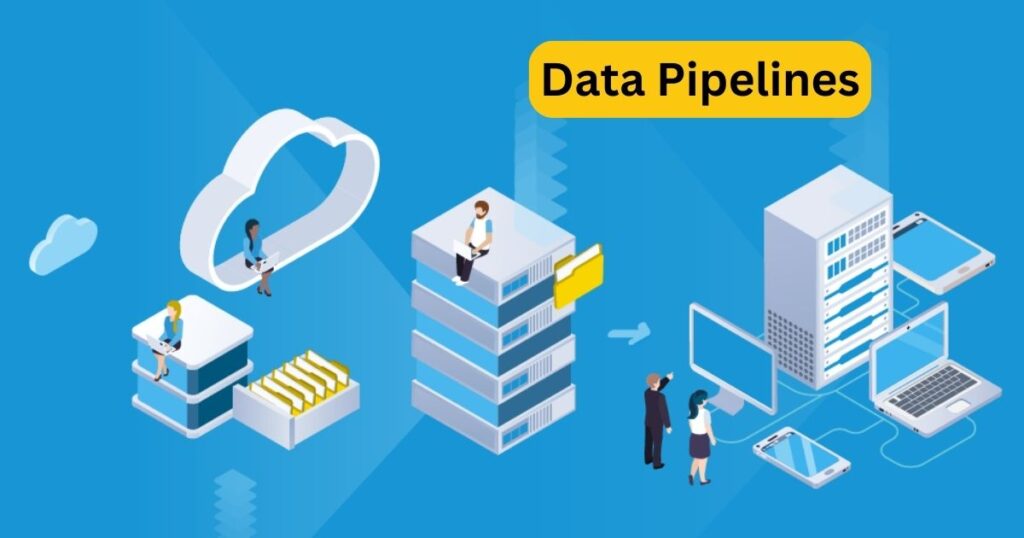
Introduction
In the digital age, data pipeline has become one of the most valuable assets for businesses. It is crucial to collect, process, and analyze data efficiently to gain insights and make informed decisions. This is where data pipelines come into play. In this comprehensive guide, we will delve into what data pipelines are, how they work, their benefits, challenges, best practices, and real-world examples.
What is a Data Pipeline
It is a series of processes that ingest raw data from various sources, transform it into a usable format, and load it into a destination for storage or analysis. Think of it as a plumbing system that allows data to flow from point A to point B seamlessly. it play a critical role in modern data architecture by enabling organizations to handle large volumes of data efficiently.
Components of a Data Pipeline
1. Data Sources
It start with collecting data from diverse sources such as databases, applications, sensors, social media, and more. These sources can generate structured, semi-structured, or unstructured data, creating the need for proper handling and processing.
2. Data Ingestion
The next step involves ingesting the raw data into the pipeline. This process can be batch-oriented (periodic intervals) or real-time (streaming). Data ingestion ensures that the data is collected reliably and efficiently for further processing.

3. Data Processing
Once the data is ingested, it undergoes processing to clean, enrich, aggregate, or transform it according to business requirements. Data processing may involve tasks like filtering out irrelevant information, correcting errors, and structuring the data for analysis.
4. Data Storage
After processing, the data is stored in a suitable repository such as a data warehouse, data lake, or cloud storage. Proper data storage is essential for easy access, scalability, and security of the processed data.
5. Data Analysis
The final stage of this involves analyzing the processed data to extract valuable insights. Data analysis can include querying the data, running machine learning algorithms, generating reports, or visualizing the information for decision-making purposes.
How Data Pipelines Work
It follow a sequential flow of operations to ensure that data is collected, processed, and analyzed efficiently. Let’s walk through the typical workflow of a data pipeline:
- Data Collection: Raw data is collected from various sources such as databases, APIs, logs, or IoT devices.
- Data Ingestion: The raw data is ingested into the pipeline either in batches or real-time streams.
- Data Processing: The ingested data undergoes cleaning, transformation, and enrichment to make it ready for analysis.
- Data Storage: The processed data is stored in a centralized repository for easy access and retrieval.
- Data Analysis: Analysts or automated systems analyze the stored data to derive insights and make informed decisions.
Benefits of Data Pipelines
Implementing these pipelines offers numerous benefits for organizations looking to harness the power of their data effectively:
- Scalability: Data pipelines can handle large volumes of data, making them scalable as business needs grow.
- Efficiency: By automating data processes, pipelines improve operational efficiency and reduce manual errors.
- Real-time Insights: Real-time pipelines enable organizations to access up-to-date information for quick decision-making.
- Data Quality: Through cleansing and transformation steps, pipelines enhance the quality and reliability of the stored data.
- Cost Savings: Automation and optimization of data workflows lead to cost savings in the long run.
Challenges in Building Data Pipelines
While these pipelines offer significant advantages, they come with their own set of challenges that organizations need to address:
- Complexity: Designing and managing pipelines can be complex, especially when dealing with diverse data sources and formats.
- Data Security: Ensuring the security and privacy of data throughout the pipeline is crucial to prevent breaches or leaks.
- Monitoring and Maintenance: Continuous monitoring and maintenance are required to keep the pipeline running smoothly and efficiently.
- Scalability Issues: Scaling a data pipeline to handle increasing volumes of data without compromising performance can be a challenge.
Best Practices for Data Pipeline Implementation
To overcome challenges and maximize the benefits of data pipelines, consider the following best practices:
- Define Clear Objectives: Clearly define the goals and requirements of your data pipeline to align with business objectives.
- Choose the Right Tools: Select tools and technologies that best fit your data pipeline needs in terms of scalability, compatibility, and efficiency.
- Data Quality Assurance: Implement measures to ensure data quality at each stage of the pipeline to maintain accuracy and reliability.
- Monitor Performance: Set up monitoring tools to track the performance of your data pipeline and identify potential bottlenecks or issues.
- Regular Maintenance: Schedule regular maintenance tasks such as cleaning up unused data, optimizing workflows, and updating dependencies.
Real-world Examples of Data Pipelines
1. E-commerce Platform
An e-commerce platform utilizes a data pipeline to collect customer interactions, process transactions, analyze buying patterns, and personalize recommendations in real-time.
2. Healthcare Analytics
Healthcare providers use data pipelines to aggregate patient records from multiple sources, perform predictive analytics for disease management, and improve treatment outcomes.
3. Financial Services
Financial institutions rely on data pipelines to monitor transactions for fraud detection, assess risk factors in real-time, and generate reports for compliance purposes.
conclusion
data pipelines are indispensable tools for organizations seeking to leverage their data assets effectively. By understanding how data pipelines work, their benefits, challenges, best practices, and real-world applications, businesses can optimize their data workflows for improved decision-making and competitive advantage in today’s data-driven world.
Read this : Best tips for Mastering Apache Airflow in 10 Minutes
